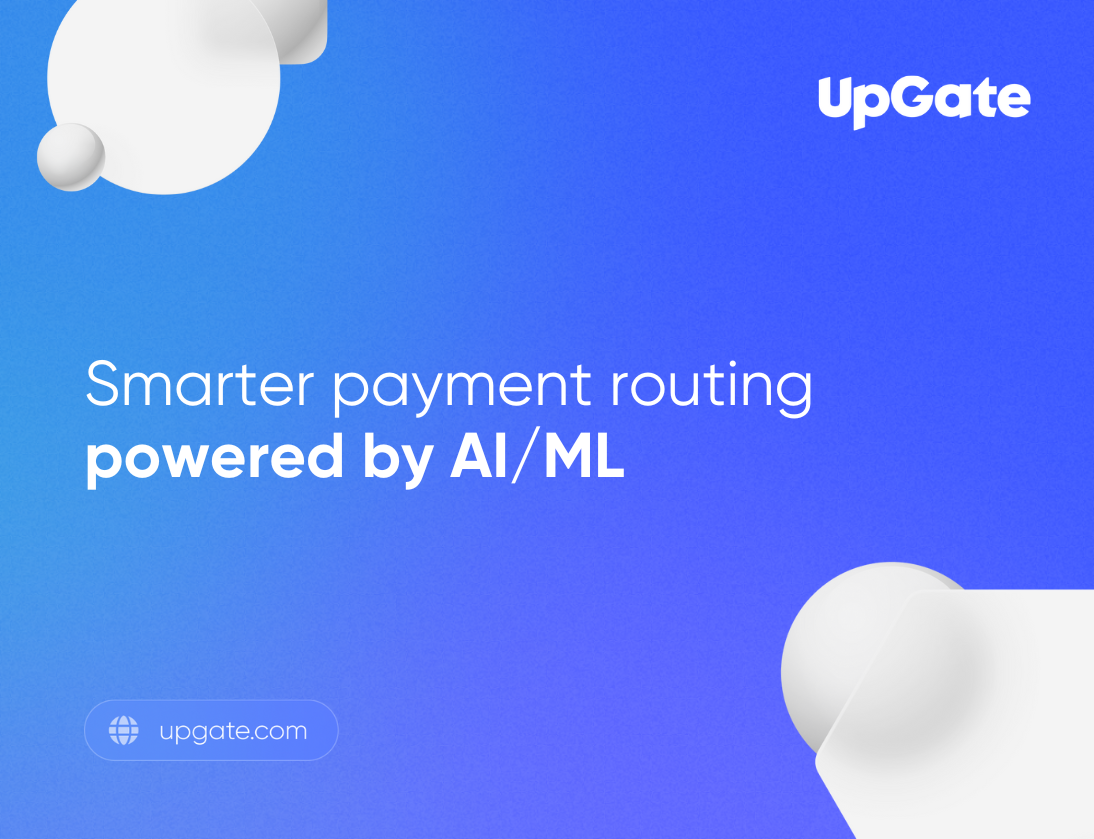Smarter Payment Routing Powered by AI/ML
Discover how our new feature helps merchants improve approval rates while retaining full control over routing decisions.
In the payments world, a single rejected transaction is more than just lost revenue; it’s lost trust, extra friction for the merchant, and a negative experience for the customer. UpGate is introducing a new feature, ML Routing, that uses artificial intelligence and machine learning to help merchants improve approval rates while retaining full control over routing decisions. Here’s why this matters, how it works, and what merchants can expect.
Why AI/ML is important for routing payments
Traditionally, routing payments has depended mostly on static rules: for example, “all Visa cards go to Processor A unless the BIN is in this list, then Processor B,” or simply choosing the lowest-cost processor first. Those static rule-based systems are simple, predictable, but limited. They cannot adapt quickly to changing issuing bank policies, time-of-day effects, or performance fluctuations in real time.
AI/ML routing brings several advantages:
Adaptive decision-making in real time, using features drawn from individual transactions and historical data.
Better handling of edge cases: unusual BINs; countries or card types with low data; new or changing processor performance.
Continuous learning: the system can detect shifts (for example in issuer behavior, changes in fraud filters) and adjust routing to maintain high approval rates.
Optimization trade-offs: e.g. balancing approval rate vs cost vs latency or risk.
Many payment providers, marketplaces, and processors are now reporting concrete improvements after adopting ML or hybrid ML + static routing:
Statistics and industry evidence
Here are some real-world examples to show what kind of improvements are plausible:
Worldline’s AI-powered routing pilots reported increases of more than 2% in addition to an existing ~3% gain from rule-based routing. FinTech Magazine
Some sources say AI routing can cut decline rates by up to 15% in the first 90 days. Onramp Funds
Razorpay’s “Optimizer” product claims businesses can experience up to 10% increase in Success Rates (i.e. more authorizations) by using ML-driven routing based on hundreds of parameters. Razorpay
In tests at Worldpay, using dynamic routing + retries + other optimizations delivered about 8.1% increase in approval rate and a 12.7% drop in false declines within 60 days. Worldpay
These numbers show that ML routing frequently adds marginal gains (a few percent) over already reasonable baseline routing logic, but those gains can translate into meaningful revenue and fewer customer-friction points.
How ML Routing works at UpGate
UpGate’s ML Routing is designed with transparency, control, and predictability in mind, even while leveraging the power of machine learning. Below is how it works, what goes into it, and how merchants can use it.
Optimized decisions per transaction: Our model predicts which processor is most likely to approve each payment by analyzing factors such as card type, country, BIN, time, and past performance.
Proven lift in approvals: Testing shows an increase of 5–10% approval rates compared to static rule-based routing.
Continuous learning: A small portion of traffic is intentionally sent to alternative processors, allowing the system to adapt to new processors and shifting performance trends.
Smart data coverage: When enough history is available, ML uses merchant-specific data. If not, it relies on a pooled dataset to ensure meaningful predictions for newer or lower-volume merchants.
Full merchant control: Merchants decide where ML is applied, which processors are included, and what percentage of traffic uses ML. Static routing priorities remain in place, so rules like BIN-based routing can still take precedence.
Optimized cascading: Both initial attempts and retries can be handled by ML, increasing the chances of successful approvals.
What merchants can expect: impact & trade-offs
In our internal tests, merchants using ML Routing saw 5-10% higher approval rates compared to their static routing baselines. This means fewer false declines, fewer lost sales, and better conversion.
Because ML needs sufficient data to be most confident, the largest gains tend to come for merchants with moderate to high volumes; for smaller or new merchants the gains are smaller but still positive thanks to pooled data fallback.
There is a trade-off with cost, latency or risk: sometimes a processor with slightly lower approval chance might have much lower fees; sometimes ML may pick a more expensive processor if that gives higher approval. Merchants control this by limiting processor list, using static rules, or adjusting ML traffic percentage.
If you want to know more about this and all the features UpGate has to offer, book a demo and follow us on LinkedIn to stay up to date with our products.